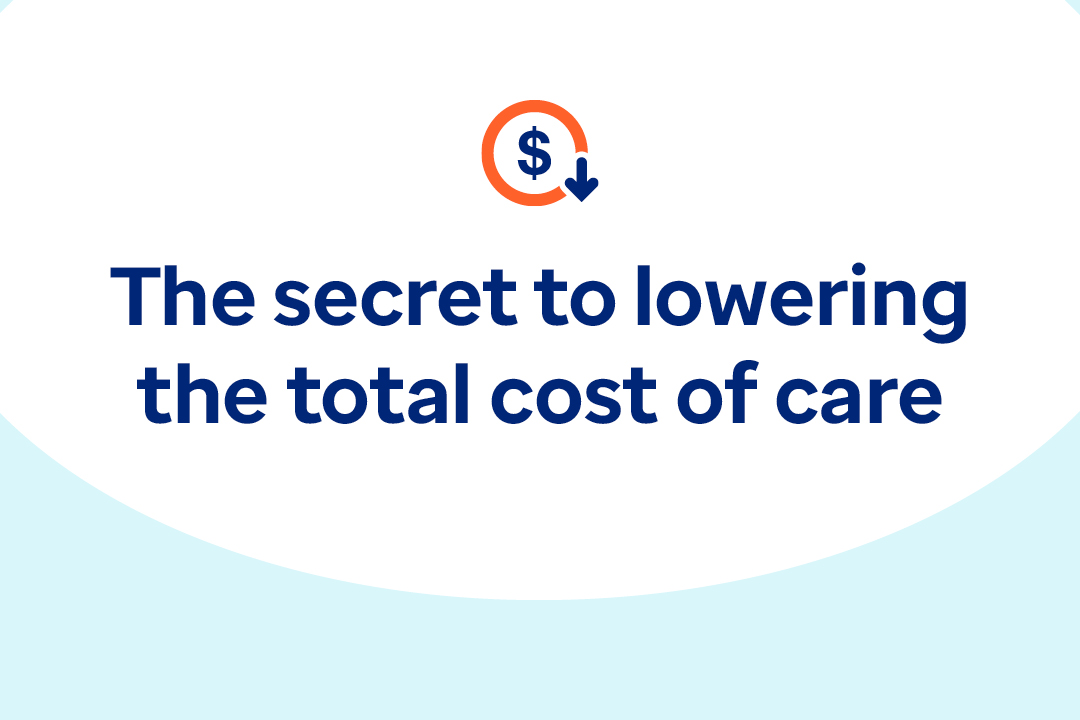As increasingly expensive medications continue to enter the market and questions about prescription drug affordability become everyday topics of conversation, the pharmacy benefit management (PBM) space is undergoing profound changes.
To get a sense of the forces driving these changes, Optum Rx Senior Vice President of Clinical Consulting Scott Draeger welcomed Optum Rx President and Chief Operating Officer Jon Mahrt for a recent episode of the Pharmacy Insights Podcast. Together they discussed how issues of access, affordability and transparency have become the new imperatives for pharmacy benefit management and the new innovations addressing these challenges.
Listen to the full “How Choice and Transparency are Changing the PBM Industry” podcast episode or read the lightly edited excerpts of this timely conversation here.
Affordable access to prescription drugs
Scott Draeger: Jon, let's begin from a foundational perspective. Can you talk a little bit about what Optum Rx does from a core business standpoint?
Jon Mahrt: Sure. Great place to start. Optum Rx is a comprehensive pharmacy care management and pharmacy care services company. We serve constituents across the health care ecosystem. I'll focus on the core of our business pharmacy benefit management, or PBM, which essentially serves employers, health plans, labor groups, those folks who are looking to provide health benefits.
For them, we provide full pharmacy benefit management, from plan design all the way through administration and clinical programming. We help them to manage and administer the pharmacy benefit and stretch that health care dollar for their constituents as far as they can.
We also have a very robust portfolio of consumer or patient-facing services as well under the Optum Rx umbrella. We have our integrated pharmacies, with a nationwide footprint of 700 Genoa pharmacies. We have our home delivery and specialty pharmacies, as well as infusion pharmacies and rare and orphan disease pharmacies.
Essentially, the way to think about it is that we have a pharmacy solution for virtually every pharmacy need that a patient might have and our direct-to-consumer offering through the Optum Store. So we have a robust and growing direct-to-consumer business, featuring a full array of pharmacy-oriented and pharmacy-related health care products.
Scott: Jon, it seems that pharmacy benefit managers and pharmacy pricing are coming up more and more in the mainstream media. What are the forces you think that are driving this?
Jon: Sure. Well, you're right. It’s in the mainstream media. It’s certainly popular on Capitol Hill and the policymaking fronts right now. The same things are on our mind as well. Affordability: that is top of the list, right? Providing affordable access to prescription drugs. And when affordability becomes an issue, it hits a lot of radars.
When you peel back the layers there's perhaps a historical lack of transparency in the PBM space. How does pricing work? How does money get from the pocket of the consumer or the plan sponsor to pharma and what happens in the middle? But behind that, it really boils down to affordable access to prescription drugs and putting this front and center.
Increasing PBM transparency
Scott: Jon, that term, I heard you mention transparency. From an employer standpoint, what does transparency mean in the pharmacy pricing space?
Jon: Yes, I love that question, Scott. It's one that we talk about frequently and really have done a lot of work to understand and to ensure that when we use the word transparency, we can look eyeball-to-eyeball with any one of our employer clients, any client, and ensure that we're saying the same thing and that we're attacking it the same way.
I think transparency starts with trust. Then, it's how do you bring that trust to life? For us, transparency starts with full visibility to drug pricing.
We've been in the market with pass-through pricing options, bringing full visibility to how that drug pricing works and how the modeling is done. And then it's what I call the “flow of money” visibility. As rebates are paid by pharma, it's being able to be very transparent and demonstrate that the dollar is making it back to that client, to that employer.
We've attacked this a number of ways. We were first to market with PreCheck MyScript. Now, more than 90% of prescribers across the country have access. What that does is it says, "Hey, when you're in the prescriber's office, you see a price, it's going to match the price that you pay at the pharmacy counter.” It allows the physician to have a discussion on pricing while the patient is in their office.
Then late last year, we went into the market with our new pricing models for our clients. What these allow our clients to do is to choose a fully pass-through, very predictable pricing model that gives them complete transparency and predictability.
And then in January of this year, we launched Price Edge. And Price Edge is our consumer-facing tool that allows members to — at their fingertips — ensure that they're always getting the lowest available price, whether on or off the pharmacy benefit. And so already this year we have more than a million members enrolled. We've saved them more than $4.5 million. We have another 90 clients going live as we speak, and an aggressive, pretty ambitious roadmap behind this. We'll soon see Price Edge 2.0 in the market with additional capabilities.
Scott: Jon, some of those transparency examples you gave from a pricing perspective make a lot of sense. What other types of transparency are your clients asking for from Optum Rx?
Jon: Clients don't see the entire scope of how drug prices are negotiated. What they want is for us to come forward and talk to them about how the full system works. So, at the top, we provide our clients with full transparency on how formulary decisions are made, showing them that we are putting the lowest-net-cost drug on the formulary and showing them the math, showing them the spreadsheet. That has really, really resonated with our clients.
Second is visibility into how both pharma contracting and drug procurement work. That's a bit of a mystery to most of our clients. I like to bring our clients to the table and we walk through how pharma contracting gets done. What are the elements involved in pharma contracting? How does drug procurement get done? And, ultimately, how is a drug price determined? Our willingness to show them that is also really resonating.
There’s also reporting. Our clients want very granular reporting. Being willing to say, "Hey, I will show you that reporting down to the patient level, down to the NDC level, down to the individual drug level,” is really resonating with our clients.
Then there’s modeling. They want to know as they make certain decisions, what will be the impact on their spend. So, it's not that we're pushing toward a point of view, we're educating our clients and then providing models for how it will impact their spend.
Then, finally, behind all of that are the most comprehensive audit rights in the industry. This allows us to provide a full flow of money visibility from pharma through a group purchasing organization, which is headquartered in the U.S., with pharma contracts that are on U.S. paper all the way through the PBM and to the client. And so, it's that comprehensive suite of transparent business practices that resonate with our clients.
Expanding client choice
Scott: Jon, it seems that the only thing that is constant in the health care industry is change. Historically, as you look back, how has Optum Rx contracted from a pricing standpoint with plan sponsors in the past? And how is that changing now with these cost-made-clear pricing models that you referenced earlier?
Jon: The good news for us is we've always provided traditional options and then pass-through options. We've really made it a client choice.
What's changed now is the education, the resources, the visibility, and the modeling that we're providing behind that. And now we're providing additional options. Late last year, again, we took an industry-leading position on this and launched our Cost Made Clear models and included in those models a pass-through model. So, what we reimburse the pharmacy, is what you as the client pay. It increases transparency, lowers ingredient costs for our plan sponsors.
And then we included another, which is a Cost Clarity model. And what Cost Clarity does is leverages a reference price or a cost baseline. In this case, it's NADAC, which stands for the National Average Drug Acquisition Cost. This is a wholesale acquisition cost to establish a kind of reference price or a baseline price that clients can use for some level of predictability.
And so, these models then serve to lower ingredient costs. They align incentives for us. It's really about how effectively we negotiate our agreements. But I think what our clients most appreciate is that they have the option. They have choice now. And as they have that choice, they can choose the transparent option that works for them. They get all of that value with a very simple admin fee. It becomes very easy to explain.
Scott: So, Jon, you mentioned the admin fee. If I were a client, I would ask, “What does that admin fee get me?” Can you talk a little bit about the value that that admin fee provides back to a client or a plan sponsor?
Jon: Your very first question to me was our core business. I explained a little bit about what a PBM or a pharmacy benefit manager does. When you think about the thousands of Optum Rx team members, there's a lot of work that goes on.
For example, there’s a fully independent pharmacy and therapeutics committee with physicians from across the industry, vetting all of the drugs that are in the market, choosing the most efficacious drugs, making sure we have formularies that meet every patient's needs. So, there's a lot of work that goes into formulary design.
Then you have formulary administration managing. There are new drugs coming to market, drugs pulled off the market. Of course, once you have the formulary going, you need to negotiate with pharma. We have a very large industry relations team that does just that.
Then there's procuring the drug and the benefit plan design. We need to understand the choices that are available and which clinical programs we should deploy based on very unique population needs of each client. Maybe it's putting a diabetes program in place or deploying one of our behavioral health programs or our opioid program. So, there's a vast array of clinical programs designed to address the specific needs of a population.
Of course, you also have the day-to-day operations. This is the member care and customer service, all the benefits administration and changes made throughout the year. All of that work rolls into an admin fee that is now very simple, easy to understand and predictable.
Evolving and transforming the PBM model
Scott: Jon, Optum Rx has always been active on the innovation front. This certainly is not the first innovation from Optum Rx aimed at evolving and transforming the PBM model. Can you take a few minutes and explain to us how this fits into the broader scope of Optum Rx initiatives?
Jon: So, I'll go back to where I started and some of your questions about what is driving scrutiny, what gets attention: access, affordability and transparency. Our focus throughout the year and the investments we make are placed in the advancement of those three imperatives. Access, affordability and transparency.
When you evaluate some of the work, it's innovation and market-leading positions that allow us to drive each of these. So, I'll give a couple of examples.
There is biosimilars. We were first to market with an industry-leading biosimilar position. Our biosimilar position was innovative, it had provided choice in the class, and we allow our clients to put the low-list-price biosimilar on the formulary as well. It’s just a really different way of thinking and a really different way of leaning in.
Scott, your team has done some great work with the critical drug affordability list. This is something that I'm especially passionate about. And so that says, "Hey, we're going to look across these life-sustaining drugs and we're going to work with each client to provide the affordability needed such that these critical drugs can be provided at $0 or reduced copays."
I mentioned Price Edge earlier. I'll back up before that to when we launched PreCheck MyScript several years ago. PreCheck MyScript was new and innovative, and we were told it'll take us 10 years to get this pushed out into the market. Well, in just a few years we're at 90% of the market now on that tool. And physicians want more and physicians want to see cost to plan.
But now layer in Price Edge. Just two years ago, we were told that if we implement something like this, you'll break the PBM. Now it's our hottest offering in the market because it provides a solution for both transparency and for affordability. We're removing those barriers.
So, there's a vast assortment of ways we're tackling the hardest problems in pharmacy right now. Take management of specialty drugs. We have a robust portfolio of specialty management solutions under the Specialty Fusion umbrella that are delivering material savings for our clients north of $15 PMPM. That’s really resonating and also one of our hottest products right now.
Now we are deep into the development of obesity management solutions. We recently hosted pharma for a couple of days of working sessions. The goal was really getting deep into how we are going to lower the list price of these expensive new obesity drugs. And then, when those drugs are prescribed and dispensed, how are we going to make sure that they're effective? So, we want to combine those weight loss medications with programming around utilization management and behavior modification programming to ensure that the client is getting the most bang for the buck as well as the healthiest employee or plan member that's possible.
Scott: Jon, I want to thank you for taking time today to discuss some of the exciting things you and your colleagues are working on at Optum Rx. So, thanks again and really appreciate your time.
Jon: Thanks for having me, Scott. We're having a lot of fun and sincerely appreciate the time today.

Article
The secret to lowering the total cost of care
Rising pharmacy costs concern everyone. Managing the underlying health conditions behind each prescription is key to addressing these high costs.

Articles
Orphan drugs market: Can we afford them?
We examine key questions around orphan drugs such as why they're so expensive, how they're being used and what plan sponsors should do next.

Article
Biosimilars to save billions in this decade
Prices for popular brand-name biologics drop up to 60% with generic-equivalent biosimilars.



